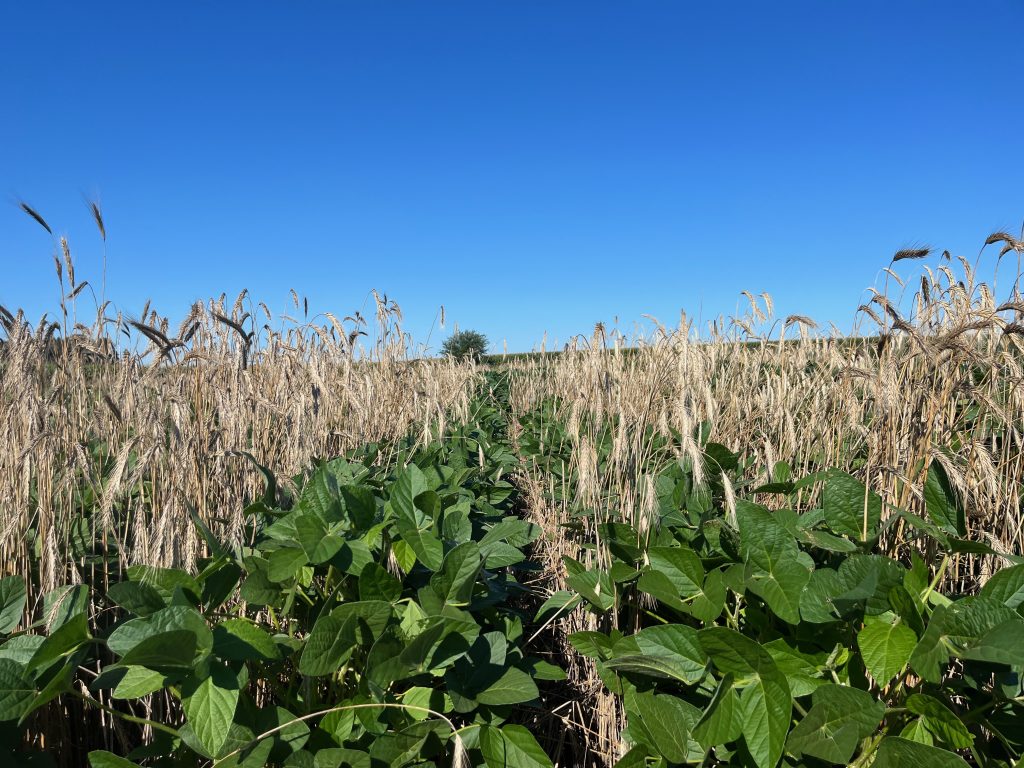
Guilherme Chudzik is a doctoral student in Dr. Rodrigo Werle’s WiscWeeds lab. Photo by Michael P. King
Each year, the Foundation for Environmental Agriculture Education (FEAE) awards their Dr. Edward H. Lloyd Memorial Scholarship to an outstanding graduate student studying crop production or a similar subject. The scholarship was created in memory of Dr. Edward H. Lloyd, a respected researcher and founder of the National Alliance of Independent Crop Consultants (NAICC).
This year, the FEAE awarded the Dr. Edward H. Lloyd Memorial Scholarship to Guilherme Chudzik, a doctoral agronomy student advised by Dr. Rodrigo Werle.
Dr. Werle runs a research and Extension program known as WiscWeeds. The WiscWeeds lab studies and shares information for Wisconsin and Midwest farmers and their advisors on how to manage some of the most common and troublesome weeds in corn-soybean production systems. This work includes identifying the most prevalent weeds, analyzing current management practices, and researching more efficient and sustainable solutions.
Chudzik began his work in the WiscWeeds lab in 2022 when he joined the Department of Plant and Agroecosystem Sciences as an agronomy master’s student. As part of his research, Chudzik conducted a survey with Wisconsin farmers and crop consultants to understand whether and how they manage cover crops for weed suppression.
Through this survey, Chudzik identified that Wisconsin farmers are struggling the most with giant ragweed and waterhemp but that cover crops can help. Chudzik used this information to test weed management solutions under field conditions in Wisconsin and Nebraska prioritizing efficiency and sustainability. “We found that adjusting planting times and adopting cover crops can be highly beneficial for giant ragweed management and soybean production,” Chudzik says.
Chudzik’s research indicated that delayed soybean planting reduced giant ragweed density in most treatments. However, this method could also result in lower soybean yield, particularly in Wisconsin. Chudzik also found that integrating cereal rye cover crop with preemergence herbicides proved effective in reducing giant ragweed populations, particularly in Nebraska, where weed emergence occurs within a shorter time window. “Comparing results from both locations allowed us to better understand how regional differences in giant ragweed emergence patterns influence management outcomes,” Chudzik says.

Research plot with late terminated cereal rye in a soybean field at the Arlington Agricultural Research Station. Photo by Guilherme Chudzik
Cover crops, an integral part of Chudzik’s research, are widely known for their soil health benefits, including enhancing soil structure, increasing organic matter, and promoting microbial activity. Among them, cereal rye has gained particular attention due to its ability to overwinter and accumulate substantial biomass in the spring across the Upper Midwest.
One approach gaining traction that uses cereal rye is called planting green. In this method, soybean is planted into a living cereal rye cover crop before termination. This strategy allows farmers to achieve both early soybean planting and sufficient cereal rye biomass accumulation for effective weed suppression. The WiscWeeds lab has been one of the pioneers of this practice in the U.S., conducting extensive research to optimize its effectiveness for farmers in Wisconsin and the Midwest.
For his doctoral work, Chudzik is focusing on strategies such as planting green and their impact on waterhemp. “We are conducting an experiment in collaboration with universities across more than 10 states,” says Chudzik. “The main goal of this research is to determine how long soybean and cereal rye cover crop can coexist in the field (both growing together) before we terminate the cereal rye, without negatively impacting soybean yield to help improve waterhemp management.”
Chudzik and the WiscWeeds team are also studying how soil type influences the persistence and effectiveness of residual herbicides. Results will help farmers select and time their herbicide application for specific soil conditions.
The FEAE’s Dr. Edward H. Lloyd Memorial Scholarship will help Chudzik continue this important research.
